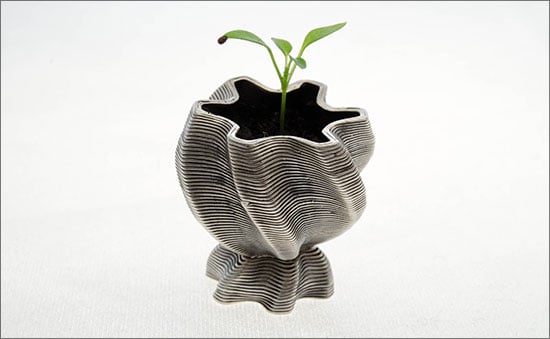Materials: silver (PMC Pro)
Dimensions: 18mm height and 23mm in diameter at its largest point.
The vessel was based on the fractal nature of a seashell; this shape was chosen as organic forms are notoriously difficult to recreate. The organic theme is also analogous with the rapid prototyping process used, as the seashell is literally ‘grown’ in the machine. The theme was further reflected by exaggerating the texture produced by the manufacturing process, which is reminiscent of seashells.
The addition of the plant conceptually closes the cycle; from the inspiration of nature itself through inorganic construction to end up as a vessel containing life.
Photo credit: Esteban Schunemann
Esteban Schunemann
Brunel Univeristy. London, UK
As an industrial designer and researcher at Brunel University, I am investigating the deposition of paste-like materials for Rapid Prototyping in a number of design contexts, including medical, craft, product and open design.
I draw my inspiration from repetitive patterns found in nature such as fractals and hyperbolic tessellations. These patterns help me device build strategies and geometries which are then fed back into the design process. The creation of a piece is not as simple as pressing print, depending on the application and geometry in mind, the process requires creative solutions to make it possible to build what is desired.
The process developed for research enables the user to build with virtually any material ranging from soft rubbers to metals. The materials are built up layer by layer in a bottom up configuration; this gives the finished pieces a stepped/layered texture.
These containers and vessels definitely hold their place in the world of stunning art objects as well as in the world of metalsmithing.
Since the dawn of time humans have created containers to hold things that were important to them, from large vessels to hold food and harvests to intimate containers for small precious things. They might hold memories, ashes, medicine, beverage, fruit or food - but all spring from the imagination and skill of the maker. Some have specific religious functions, some are meant for everyday use. When one thinks of a vessel or container the inclination is to think of something with solid walls - yet many of these works involve the exploration of positive and negative space, and the use of negative space to help create the illusion of the wall of the vessel.
As the world’s largest jewelry related internet site, Ganoksin strives to develop exhibitions showcasing work from around the world. This exhibition was open to all metalsmiths, professional and amateur, advanced and beginner. Participants are from The Netherlands, the USA, Canada, Australia, Costa Rica, the United Kingdom, Israel, Hong Kong, Colombia, Romania, Italy, Ireland, Japan, Malaysia and Denmark. While most of the pieces are by an individual metalsmith, some are collaborations, one of three artists spanning 50 years.
In total 319 artists contributed 729 show pieces for the permanent online exhibition.
Objects in the exhibition include boxes, lockets, urns, ash containers, bowls, wine cups, reliquaries, match holders, vases, teapots, pitchers, sugar bowls, baskets, nests, pillboxes, clutches and a range of sculptural forms. A variety of techniques are showcased covering a wide range of metalsmithing techniques. Materials used include everything from gold and silver to less expensive metals. Ornamentation includes the addition of enamel, chasing and repousse’, gemstones and found objects.
The exhibition was curated by Beth Wicker, President of the North Carolina Society of Goldsmiths in the United States, and Adjunct Instructor at Northeastern Technical College in South Carolina. Director of the exhibition is Hanuman Aspler, founder of The Ganoksin Project, the world’s largest internet jewelry site.
